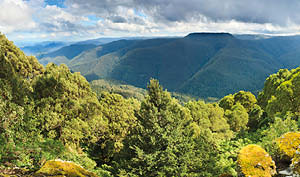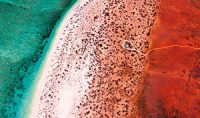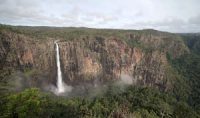JOHN McNAMEE REPORTS
Campaigning rock musician and dedicated conservationist Peter Garrett claims it’s the voice of the public which has helped preserve some of Australia’s unique World Heritage Sites.
The former Federal Environment Minister says the drive to see special places identified and given this international status has nearly always come from the people, especially non-government environment organisations and the academic community.
The Midnight Oils front-man was making his comments in a foreword of a magnificent new book, World Heritage Sites of Australia by well-known environmental expert and author Peter Valentine, an adjunct professor at James Cook University.
“World Heritage listing is a gold star recognition, but by itself does not guarantee adequate protection of a site,” Garrett explained in his foreword.
“Locations such as Ningaloo Reef….and the Great Barrier Reef are in serious jeopardy and the need for public voices calling on governments to ensure our World Heritage sites are not degraded and diminished over time has never been greater.
“Of special significance are those locations like Uluru-Kata Tjuta and Kakadu, that evidence thousands of years of human occupation by Aboriginal and Torres Strait Islander peoples.
“These are living landscapes of timeless beauty that continue to sustain indigenous populations. There is literally nothing like them on the planet,” he writes.
Remarkably the decision to generate a list of places of “notable global heritage significance” was only made in 1972.
Garrett writes: “Visitors to Australia marvel when they discover these locations…. which abound on our continent.
“Their dazzling ecological complexity, astonishing beauty and rare quality energises this exhaustively researched publication by Peter Valentine.’

As well as sites such as the Great Barrier Reef, Kakadu, Uluru and the Greater Blue Mountains, Professor Valentine also chronicles other notable locations such as the spectacular Gondwana Rainforests, the Willandra Lakes, Shark Bay and Purnululu National Park in WA, Australian Fossil Mammal Sites in Queensland and South Australia and the awesome Tasmanian Wilderness.
Professor Valentine provides a fascinating historic and photographic guide to 19 of Australia’s World Heritage Sites and each role they play in shaping our natural and cultural history.
A classic example of this research includes a description of the Willandra Lakes Region in NSW, “where an understanding of climatic oscillations, combined with the archaeological evidence of human occupation 45,000 to 60,000 years ago, led to the dramatic revision of previous estimates of indigenous occupation in Australia.”

Recounting some of the background to the early sites included in the new heritage listings, Prof Valentine writes that the first properties to be inscribed in 1978 included such obvious gems as the Galapagos Islands (Ecuador), Yellowstone National Park (USA), the Historic Centre of Krakow (Poland) and the medieval Rock-hewn Churches, Lalibela (Ethiopia.) The Nubian Monuments of Philae (Egypt) were added in 1979.
Australia was one of the first countries to join the World Heritage Convention, in 1974, with sites in every and territory except the ACT.
There are many personal moments too in the book, including an account of Valentine’s meeting with Bill Neidjie, a Kakadu Elder of great standing and possibly the last speaker of the Gadudju language.
He includes this “poem’ by Bill;
Animals like family to us,
Earth our mother,
Eagle our cousin,
Tree is pumping blood like us,
We all one.

Valentine writes: “I first visited Kakadu National Park in 1989. Among many highlights was a deeply emotional experience when I sat on a rocky platform with Elder Bill Neidjie on his own country, at the edge of extensive wetlands, while he explained what it meant to him to be on country.
“His passion for the place was palpable, as was his clear desire to share it. I understood the generosity of the indigenous people in sharing such a magnificent place with the rest of the world.
This struck me as a testament to the meaning of world heritage.
“Later, I watched a sunset from Ubirr, and was awed by the timeline of the land, as I gazed across the plains that had for so long been the home of spectacular wildlife and the first Australians.
“I had goose-bumps appreciating all that had gone before and a great hope that this place could continue to provide inspiration and meditation for future generations.
“Sadly, Bill Neidjie dies in 2002.”
Valentine also writes passionately about many of the iconic places he describes in the colourfully illustrated book.
One of the more spectacular is the sprawling expanse of the Gondwana Rainforests, located along the central east coast and consisting of 41 separate areas, that extend from the Barrington Tops National Park in NSW to Main Range National Park in Queensland.
Ten of the areas are more than 10,000 hectares including such well-known national parks as Border Ranges, Washpool, New England and Lamington.
As well as their dramatic post volcanic history, and sweeping mountainous vistas, Gondwana is home to many unique flora and fauna.
“The forests themselves are distinctly different and provide unique ecosystems and experiences for visitors. The plant forms, diversity and colours of the area’s subtropical rainforests are similar to those in northern Queensland.
“They include epiphytic orchids and numerous ferns…..
“There are also almost as many frog species in the Gondwana rainforests (45) as in the tropical rainforests…similarly there are many reptiles confined to these reserves. One of these is the land mullet, one of the largest skinks in the world, growing to 60 centimetres in length.
“We now know that songbirds, one of the greatest gifts to nature across the world, originated in Australia. Two species of lyrebird, perhaps the greatest songsters of all birds, live in this World Heritage area. They’re known to mimic such noises as chainsaws, camera shutters and car alarms.
“Other ancient songbird lineages in the area include scrub-birds, treecreepers, bowerbirds, as well as a single endemic bird of paradise species, the paradise riflebird.”
Author Valentine also points out the similarities and differences between the Great Barrier Reef for example and the Ningaloo Marine Park in WA.
He writes: “The Ningaloo Reef is remarkably rich in wildlife, with more than 300 species of coral, more than 700 species of reef fish and more than 600 species each of mollusc and crustacean.
“Apart from the six species of marine turtle recorded in the area, there are many ray and shark species and open ocean fish species such as mackerel, marlin and sailfish.
“Each year, migrating humpback whales pass through Ningaloo on their way to calving grounds off the Kimberley coast and then again on their return to Antarctic waters.”
It is such fascinating information as this, along with the eye-catching photographs, that make Peter Valentine’s book an extraordinary journey.
To try to do justice to some of the personal and historic gems, I’ve made a random selection of passages from the easy-to-read pages. But nothing I write can adequately capture the magic of this unique depiction of the wonders of our Australian landscape. For around fifty bucks, you won’t get a better literary experience.
- World Heritage Sites of Australia. By Peter Valentine. NLA Publishing. RRP $49.99. Available now.
****************************************************************




